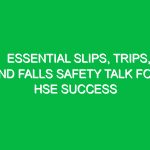Introduction
Slip and trip incidents are among the most common causes of workplace injuries. They can lead to serious injuries, affecting not only the health of employees but also the productivity and morale of the workplace. Understanding the significance of slip or trip Prevention is crucial in the Health, Safety, and Environment (HSE) domain. These incidents can occur in various environments, from offices to construction sites, and their implications can be severe, including lost workdays, increased insurance premiums, and even legal ramifications.
In this article, we will explore essential slip and trip prevention tips that every organization should implement to foster a safer workplace. By understanding the causes, risks, and preventive measures, businesses can create an environment that prioritizes the health and Safety of their employees.
The Importance of Addressing Slip and Trip Hazards
Slip or trip Hazards often stem from various factors, including environmental conditions, organizational practices, and human behavior. According to the Health and Safety Executive (HSE) in the UK, slip and trip incidents account for over a third of all reported workplace injuries. Not only do these incidents pose immediate physical harm, but they can also lead to long-term health issues and financial burdens for both employees and employers.
Recognizing the importance of addressing these hazards is the first step in preventing incidents. Employers have a legal obligation to ensure a safe working environment, and addressing slip or trip hazards is a critical part of that responsibility.
Common Causes of Slip and Trip Incidents
To effectively prevent slip and trip incidents, it is essential to understand their common causes:
- Wet or Slippery Surfaces: This can occur due to spills, rain, or cleaning processes.
- Uneven Surfaces: Cracks, holes, or varying floor levels can create tripping hazards.
- Obstructions: Items left in walkways, such as equipment, cords, or personal items, can lead to trips.
- Inadequate Lighting: Poor visibility can make it challenging for employees to see hazards.
- Improper Footwear: Shoes that do not provide adequate grip can contribute to slips.
Each of these causes can be mitigated through effective strategies, which will be discussed in the following sections.
Preventive Strategies for Slip and Trip Hazards
Conduct Regular Risk Assessments
One of the most effective ways to identify and mitigate slip and trip hazards is through regular risk assessments. Employers should conduct thorough evaluations of the workplace to identify potential hazards. This process involves:
- Inspecting walking surfaces for any irregularities or hazards.
- Reviewing cleaning Procedures to ensure they do not contribute to slippery surfaces.
- Engaging employees in reporting any hazards they encounter.
By actively seeking out potential risks, organizations can take proactive measures to address them before incidents occur.
Improve Housekeeping Practices
Good housekeeping is vital in maintaining a safe workplace. This involves:
- Regular cleaning of spills and debris promptly.
- Ensuring walkways are clear of obstructions.
- Properly storing equipment and personal items.
Establishing a cleaning schedule can help ensure that these tasks are completed regularly and efficiently.
Implement Signage and Communication
Clear communication is key to slip and trip prevention. Employers should use signage to alert employees to potential hazards. For example:
- Wet floor signs should be prominently displayed after cleaning.
- Warning signs should be placed in areas with uneven surfaces.
Additionally, holding regular safety meetings can reinforce the importance of Hazard Awareness among employees.
Enhance Lighting Conditions
Adequate lighting is essential for preventing slip and trip incidents. Employers should:
- Ensure all areas of the workplace are well-lit, particularly stairways and entrances.
- Replace burnt-out bulbs immediately.
- Consider motion-sensor lighting in less frequently used areas.
Good lighting enhances visibility, allowing employees to identify hazards more easily.
Choose Appropriate Flooring Materials
The choice of flooring can significantly impact slip and trip incidents. Employers should consider the following:
- Use non-slip flooring materials in high-traffic areas or places prone to spills.
- Regularly assess the condition of existing flooring and replace or repair as necessary.
Investing in appropriate flooring can reduce the likelihood of slips and trips occurring.
Provide Training and Awareness Programs
Education is a powerful tool in preventing slip and trip incidents. Employers should provide training that includes:
- Identifying potential slip and trip hazards.
- Understanding the importance of reporting hazards.
- Practicing safe walking techniques, especially in high-risk areas.
Training sessions can be supplemented with practical demonstrations to reinforce learning.
Encourage Proper Footwear
Footwear plays a crucial role in preventing slips and trips. Employers should encourage employees to wear:
- Non-slip shoes with adequate grip.
- Shoes that fit properly to prevent tripping.
Employers can consider providing guidelines or even subsidies for appropriate footwear.
Real-Life Examples of Effective Slip and Trip Prevention
Case Study: A Manufacturing Facility
In a manufacturing facility, management noted a significant number of slip and trip incidents occurring near the loading docks. After conducting a risk assessment, they identified several contributing factors: wet surfaces due to rain, cluttered walkways, and inadequate lighting.
In response, the management implemented several measures:
- Installed non-slip mats in critical areas.
- Enhanced lighting around loading zones.
- Established a strict cleaning protocol for spills.
- Conducted training sessions focusing on hazard awareness and Safe Practices.
As a result, the facility saw a drastic reduction in reported incidents, showcasing the effectiveness of proactive measures.
Case Study: An Office Environment
An office environment faced challenges with employees tripping over loose cables and cluttered desks. To address these issues, the management took the following steps:
- Implemented a “clean desk” policy to minimize clutter.
- Provided cable management solutions to secure cords.
- Conducted regular safety audits to identify potential hazards.
These changes fostered a safer work environment, dramatically reducing trip incidents.
Regulations and Standards Governing Slip and Trip Prevention
Many countries have Regulations in place to enforce Workplace Safety, particularly concerning slip and trip hazards. In the UK, the Health and Safety at Work Act 1974 obligates employers to ensure the health and safety of their employees. This includes managing risks associated with slips and trips.
In the United States, OSHA (Occupational Safety and Health Administration) has guidelines that employers must follow to maintain a safe workplace. These regulations require employers to identify and mitigate hazards, including slips and trips.
Understanding and adhering to these regulations not only helps prevent incidents but also protects organizations from potential legal consequences.
Conclusion
Preventing slip and trip incidents is a vital component of Workplace Safety. By implementing effective strategies such as regular risk assessments, enhancing housekeeping practices, improving lighting, and providing employee training, organizations can significantly reduce the likelihood of these incidents. The financial and emotional toll of workplace injuries underscores the importance of prioritizing safety.
In conclusion, fostering a culture of safety requires ongoing commitment and vigilance. Employers must continuously assess their work environments and adapt their strategies to eliminate slip and trip hazards. By doing so, they not only comply with legal obligations but also contribute to a healthier, more productive workplace.


